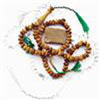
I had a question regarding the following hadith: ـ محمد بن یعقوب ، عن علی بن إبراهیم ، عن أبیه ، وعن محمد ابن إسماعیل ، عن الفضل بن شاذان ، وعن محمد بن یحیى ، عن أحمد بن محمد کلهم ، عن حماد بن عیسى ، عن حریز ، عن زرارة ، عن أبی جعفر ( علیه السلام ) قال : إذا قمت فی الصلاة فلا تلصق قدمک بالاخرى دع بینهما فصلاً إصبعاً أقل ذلک إلى شبر أکثره ، وأسدل منکبیک ، وأرسل یدیک ، ولا تشبک أصابعک ، ولیکونا على فخذیک قبالة رکبتیک ، ولیکن نظرک إلى موضع سجودک ، فاذا رکعت فصف فی رکوعک بین قدمیک تجعل بینهما قدر شبر ، وتمکن راحتیک من رکبتیک ، وتضع یدک الیمنى على رکبتک الیمنى قبل الیسرى ، وبلع أطراف أصابعک عین الرکبة ، وفرج أصابعک إذا وضعتها على رکبتیک فان (1) وصلت أطراف أصابعک فی رکوعک إلى رکبتیک أجزأک ذلک ، وأحب إلی أن تمکن کفیک من رکبتیک فتجعل أصابعک فی عین الرکبة وتفرج بینهما ، وأقم صلبک ومد عنقک ، ولیکن نظرک إلى بین قدمیک ، فإذا أردت أن تسجد فارفع یدیک بالتکبیر وخر ساجداً وابدأ بیدیک فضعهما (2) على الأرض قبل رکبتیک تضعهما معاً ولا تفترش ذراعیک افتراش السبع (3) ذراعیه ، ولا تضعن ذراعیک على رکبتیک وفخذیک ، ولکن تجنح بمرفقیک ، ولا تلزق (4) کفیک برکبتیک ، ولکن تحرفهما عن ذلک شیئاً ، وابسطهما على الأرض بسطاً ، واقبضهما إلیک قبضاً ، وإن کان تحتهما ثوب فلا یضرک ، وإن أفضیت بهما إلى الأرض فهو أفضل ، ولا تفرجن بین أصابعک فی سجودک ، ولکن ضمهن جمیعاً قال : وإذا قعدت فی تشهدک فألصق رکبتیک بالأرض وفرج بینهما شیئاً ، ولیکن ظاهر قدمک الیسرى وألیتاک على الأرض ، وأطراف (5) إبهامک الیمنى على الأرض ، وإیاک والقعود على قدمیک فتتأذى بذلک ، ولا تکون (6) قاعداً على الأرض فیکون إنما قعد بعضک على بعض فلا تصبر للتشهد والدعاء. ورواه الشیخ بإسناده عن محمد بن یعقوب ، مثله Is this hadith sahih? Thank you for any help you can provide. Wa salam
Concise answer
Considering that the narrators who have transmitted are trustworthy and reliable, the hadith can be regarded as authentic and valid. To read a short account on the narrators of this hadith, you should go through the following detailed answer:
Detailed Answer
We shall now study and verify the authenticity of the tradition which is about the apparent manners of offering prayers and which Sheikh Kulayni has reported in his Al-Kafi. The tradition reads:
«عَلِیٌّ عَنْ أَبِیهِ عَنْ حَمَّادِ بْنِ عِیسَى وَ مُحَمَّدُ بْنُ إِسْمَاعِیلَ عَنِ الْفَضْلِ بْنِ شَاذَانَ عَنْ حَمَّادِ بْنِ عِیسَى وَ مُحَمَّدُ بْنُ یَحْیَى عَنْ أَحْمَدَ بْنِ مُحَمَّدٍ عَنْ حَمَّادِ بْنِ عِیسَى عَنْ حَرِیزٍ عَنْ زُرَارَةَ عَنْ أَبِی جَعْفَرٍ (ع) قَالَ: إِذَا قُمْتَ فِی الصَّلَاةِ فَلَا تُلْصِقْ قَدَمَکَ بِالْأُخْرَى ...»[1]
Translation of the hadith:
Muhammad b. Ya`qub from `Ali b. Ibrahim from his father and from Muhammad b. Isma`il from al-Fadl b. Shadhan and from Muhammad b. Yahya from Ahmad b. Muhammad all of them from Hammad b. `Isa from Hariz from Zurarah from Abu Ja`far, peace be upon him:
He said: When you stand for prayer, do not join your foot with the other; allow a distance of a finger between them - that is the minimum - to a hand-span - its maximum, and make your shoulders droop, and lower your hands and do not interlace your fingers and let them be on your thighs against your knees, and focus your line of sight at the place of your prostration. Then when you bow, align your feet in your ruku`, placing them such that there is the (distance of a) measure of a hand-span between them, and place your palms over your knees, and place your right hand over your right knee prior to the left and make your fingertips swallow the patella and space out your fingers when you place them over your knees. So when your fingertips have reached to your knees in your ruku`, that is sufficient for you. But I prefer that you place your palms over your knees so that your fingertips are placed on the patella and that you keep space between them. And you straighten your back and stretch your neck, and direct your sight between your two feet. And when you intend to prostrate, then raise your hands with the takbeer and fall down prostrate, and begin with your hands. So place them on the ground prior to your knees. Place them together and do not spread your arms like the lion (or, a predatory beast) (the author wrote: the lion, then he struck that out and wrote: the beast of prey, from al Tahdheeb, in the margin) spreads its arms, and do not place your arms on your knees or your thighs but incline your elbows. And do not make your palms stick to/contact your knees but deflect them from that a little, and spread them over the ground, spread out, and contract them towards yourself, a contraction. And if there is some cloth beneath them, it will do you no harm but if you reveal them (i.e., remove the cloth) to the ground (viz. place them directly on the ground with no barrier in between), then it is better. And do not keep space between your fingers in your sujud but join them all together. (Then) he said: And when you sit in your tashahhud, then you make your knees stick to the ground and keep some space between them, and let the outside of your left foot and your buttocks be on the ground. And the tips of your right big toe should be on the ground. And beware of sitting upon your two feet, for you will be wronged by that. And do not perform the sitting is not, in the margin of the manuscript) on the ground; it is only because some of you sit against others, that you lack patience for the tashahhud and the supplication. "
And the Shaykh (al Tusi in al Tahdheeb) narrated it with his chains from Muhammad b. Ya`qub likewise.
The chain of the transmission of this tradition is a bit complicated because there are three chains merged into one another which are written down separately as underA:
First chain: Muhammad b. Ya'qbu from Ali b. Ibrahim from his father from Hammad b. Isa from Hariz from Zurarah from Imam Muhammad Baqir (A.S) ...
Second chain: Muhammad b. Ya'qub from Muhammad b. Isma`il from al-Fadl b. Shadhan from Hammad b. `Isa from Hariz from Zurarah from Abu Ja`far, peace be upon him ...
Third chain: From Muhammad b. Ya'qub from Muhammad b. Yahya from Ahmad b. Muhammad all of them from Hammad b. `Isa from Hariz from Zurarah from Abu Ja`far, peace be upon him...
First of all, the narrators in the chains of transmission should be verified and then the final judgment will have to be made about each one of the chains of transmission:
1. Ali b. Ibrahim known as Hashim Qummi: Najashi considers him reliable and trustworthy in transmitting traditions. He has reported that Hashim Qummi authored some books also.[2]
2. Father of Ali b. Ibrahim i.e. Ibrahim b. Hashim: He is one of the great narrators who have narrated many traditions. He is in the chains of numerous traditions. Great scholars like Allamah Hilli[3] and Allamah Mohsen Ameen[4] have considered him among the reliable and trustworthy narrators.
3. Hammad b. Isa: Known as "Ghariq Juhfa", Hammad b. Isa is one of the companions of Imam Sadiq (A.S). He is trustworthy and reliable. He has also written a book in this regard.[5]
4. Muhammad b. Ismail Bunduqi Nishaburi: There is no comment about him. He has neither been praised nor disparaged. Only Shaykh Tusi has placed him among those narrators who have directly narrated from the Infallible Imams (A.S).[6] However, given the fact that Shaykh Kulayni has quoted him and the fact that there are about eight hundred and eight narrations reported from him, he is very much likely to be trustworthy.
5. Fadhl b. Shadhan: He is one of the great companions, greater than he can be described. Najashi says concerning him: "His father was amongst the companions of Yunus. He has narrated from Imam Jawad and it is said that he has also narrated from Imam Redha (A.S). He is one of the trustworthy jurisprudents and theologians with a high position among them. He is more famous than he can be described."[7]
6. Muhammad b. Yahya al-Attar: Najashi calls him the "rein" and chief of the companions of Imamiyah in his time. He is trustworthy and reliable.[8]
7. Ahmad b. Muhammad b. Isa: He is one of those narrators who have met Imam Redha (A.S). He has also narrated from Imam Jawad and Imam Hadi, peace be upon them. He has taken narrations from many a number of the students of the school of Ahlul-Bayt (A.S) and many others have taken hadith from him. The number of narrations passed on by him reaches about 2300.[9] He is, therefore, one of the prominent narrators.
8. Hariz b. Abdullah Sajistani: He is originally from Kufa but he settled in the present day Sistan. He has reported a lot of narrations and he is reliable.[10]
9. Zurarah: He is one of the great companions of the Infallible Imams (A.S) with a high place amongst narrators and traditionists.[11]
Keeping in view the narrators in the chain of transmission and the information we provided about each one of them, now we have to study each chain of transmission independently of other chains.
First chain: The chain is reliable, even though Allamah Hilli's opinion about the reliability of Ibrahim b. Hashim is based on his own deduction (ijtihad).
Second chain: It is reliable, although there is not any special report about Muhammad b. Ismail to consider him trustworthy and reliable.
Third chain: This is the most reliable chain since all the narrators in the chain are some of the most reliable and greatest narrators. Hence, the narration in question is authentic and reliable in terms of the chain transmission of the narration and its text.
[1] Kulayni, Muhammad b. Ya'qub, Al-Kaif, vol.3, p. 334, Dar al-Kotob al-Islamiyah, Tehran, 1407 A.H.
[2] Najashi, Ahmad b. Ali, Fehris Asmaa Musannefi al-Shi'ah (Rijal Najashi), p. 260, Islamic Publications Office, Qom, sixth edition, 1365 of the Islamic solar calendar.
[3] Allamah HIlli, Hasan b. Yusuf, Khulasat al-Aqwal, p. 4, Dar al-Zakhair, Qom, 1411 A.H.
[4] Ameen Amili, Sayed Mohsen, A'yaan al-Shi'ah, vol.2, p. 234, Dar al-Ta'aruf for Publication, Beirut, 1406 A.H.
[5] Shaykh Tusi, Muhammad b. Hasan, Al-Abwab (Rijal al-Tusi), researched and edited by Qayyumi Isfahani, Jawad, p. 334, Islamic Publications Office, Qom, third edition, 1427 A.H.
[6] Ibid, p. 440.
[7] Fehris Asmaa Musannefi al-Shi'ah (Rijal Najashi), p. 360.
[8] Ibid, p. 353.
[9] Subhani, Ja'far, Mawsu'at Tabaqat al-Fuqaha, vol. 3, p. 100, Imam Sadiq (A.S) Institute, Qom, 1418 A.H.
[10] Shaykh Tusi, Al-Fehris, researched and edited, Aal Bahrul Ulum, Sayyed Muhammad Sadiq, p. 162, Al-Maktabah al-Razawiyah, Najaf, first edition, (date not known).
[11] Vide: Zurarah and Imams, question 19464
source : www.islamquest.net













